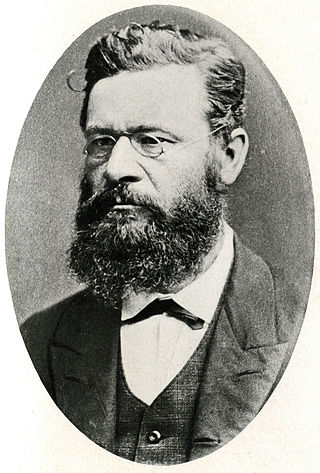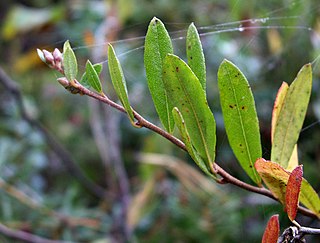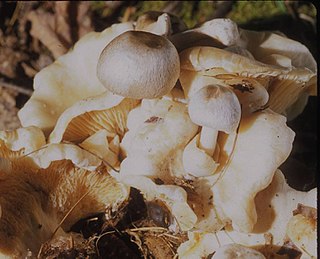Related Research Articles

Petter Adolf Karsten was a Finnish mycologist, the foremost expert on the fungi of Finland in his day, and known in consequence as the "father of Finnish mycology".

Chamaedaphne calyculata, known commonly as leatherleaf or cassandra, is a perennial dwarf shrub in the plant family Ericaceae and the only species in the genus Chamaedaphne. It is commonly seen in cold, acidic bogs and forms large, spreading colonies.

Phaeosphaeria nodorum is a major fungal pathogen of wheat, causing the disease Septoria nodorum blotch. It is a member of the Dothideomycetes, a large fungal taxon that includes many important plant pathogens affecting all major crop plant families.
Pseudopestalotiopsis theae is a plant pathogen affecting tea.
Waitea circinata is a species of fungus in the family Corticiaceae. Basidiocarps are corticioid, thin, effused, and web-like, but the fungus is more frequently encountered in its similar but sterile anamorphic state. Waitea circinata is best known as a plant pathogen, causing commercially significant damage to amenity turf grass.
Pyrenophora avenae is a species of fungus in the family Pleosporaceae. It is a plant pathogen, causing leaf stripe, blotch or spot and seedling blight of oats.

Bremia lactucae is a plant pathogen. This microorganism causes a disease of lettuce denominated as downy mildew. Some other strains can be found on 36 genera of Asteraceae including Senecio and Sonchus. Experiments using sporangia from hosts do not infect lettuce and it is concluded that the fungus exists as a quantity of host-specific strains. Wild species, such as Lactuca serriola, or varieties of Lactuca can hold strains that infect lettuce, but these pathogens are not sufficiently common to seriously infect the plant.

Uromyces dianthi is a fungus species and plant pathogen infecting carnations and Euphorbia.

Mycocentrospora acerina is a deuteromycete fungus that is a plant pathogen.
Coniothyrium glycines is a fungal plant pathogen infecting soybean.
Microdochium panattonianum is a fungal plant pathogen. This pathogen causes anthracnose of lettuce, a disease which produces necrotic lesions in cultivated lettuce. In extended periods of wet weather, M. panattonianum can cause significant crop-losses. The impact of this pathogen is exacerbated by farming lettuce without crop rotation, and by planting of susceptible lettuce varieties, such as Romaine lettuce.

Exobasidium vaccinii, commonly known as “red leaf disease,” or “Azalea Gall,” is a biotrophic species of fungus that causes galls on ericaceous plant species, such as blueberry and azalea. Exobasidium vaccinii is considered the type species of the Exobasidium genus. As a member of the Ustilagomycota, it is a basidiomycete closely related to smut fungi. Karl Wilhelm Gottlieb Leopold Fuckel first described the species in 1861 under the basionym Fusidium vaccinii, but in 1867 Mikhail Stepanovich Voronin later placed it in the genus Exobasidium. The type specimen is from Germany, and it is held in the Swedish Museum of Natural History. Exobasidium vaccinii, in current definition from John Axel Nannfeldt in 1981, is limited on the host Vaccinium vitis-idaea. This idea is used in most recent papers on E. vaccinii.
Drechslera andersenii is a fungus that is a plant pathogen. It was originally found on the leaves of Lolium perenne in Great Britain. It was also found on Italian ryegrass.
The Vizellaceae are a family of fungi with an uncertain taxonomic placement in the class Dothideomycetes. The family was circumscribed by Dutch mycologist Haring Johannes Swart in 1971. It originally held Blasdalea and the type genus Vizella. Vizellaceae species are found on all continents, particularly in tropical and subtropical regions.

Ceratobasidium is a genus of fungi in the order Cantharellales. Basidiocarps are effused and the genus is sometimes grouped among the corticioid fungi, though species also retain features of the heterobasidiomycetes. Anamorphic forms were formerly referred to the genus Ceratorhiza, but this is now considered a synonym of Rhizoctonia. Ceratobasidium species, excluding the type, are also now considered synonymous with Rhizoctonia and some species have been transferred to the latter genus. Species are saprotrophic, but several are also facultative plant pathogens, causing a number of commercially important crop diseases. Some are also endomycorrhizal associates of orchids.

Myxarium nucleatum is a species of fungus in the family Hyaloriaceae. In the UK, it has been given the recommended English name of crystal brain. The fruit bodies are watery white, pustular or lobed, and gelatinous with small, white, mineral inclusions visible to the naked eye. It is a common, wood-rotting species in Europe, typically growing on dead attached or fallen branches of broadleaf trees. It is currently not clear whether collections from North America and elsewhere represent the same species.

Volvariella surrecta, commonly known as the piggyback rosegill, is an agaric fungus in the family Pluteaceae. Although rare, the species is widely distributed, having been reported from Asia, North America, Northern Africa, Europe, and New Zealand. The fungus grows as a parasite on the fruit bodies of other gilled mushrooms, usually Clitocybe nebularis. V. surrecta mushrooms have white or greyish silky-hairy caps up to 8 cm (3.1 in) in diameter, and white gills that turns pink in maturity. The stipe, also white, is up to 9 cm (3.5 in) long, and has a sack-like volva at its base.
Roy Watling, PhD., DSc, FRSE, F.I.Biol., C.Biol., FLS is a Scottish mycologist who has made significant contributions to the study of fungi both in the identification of new species and correct taxonomic placement, as well as in fungal ecology.
Clarence James Hickman was a British-Canadian mycologist. He is noteworthy for his discovery in 1940 that the oomycete species Phytophthora fragariae is the cause of the disease red stele in strawberry plants.
References
- 1 2 Deighton, F.C. (1968). "Spermospora". Transactions of the British Mycological Society . 51 (1). British Mycological Society: 41–49. doi:10.1016/s0007-1536(68)80120-2. ISSN 0007-1536.
- 1 2 "Red leather leaf of oats". Agriculture Victoria . 2020-07-23. Retrieved 2021-07-29.
- ↑ National Biodiversity Network. "Spermospora avenae". NBN Atlas. Retrieved 2021-07-29.
- ↑ "Spermospora avenae (SPRSAV)[Overview]". Global Database. EPPO (European and Mediterranean Plant Protection Organization). 2011-08-07. Retrieved 2021-07-29.